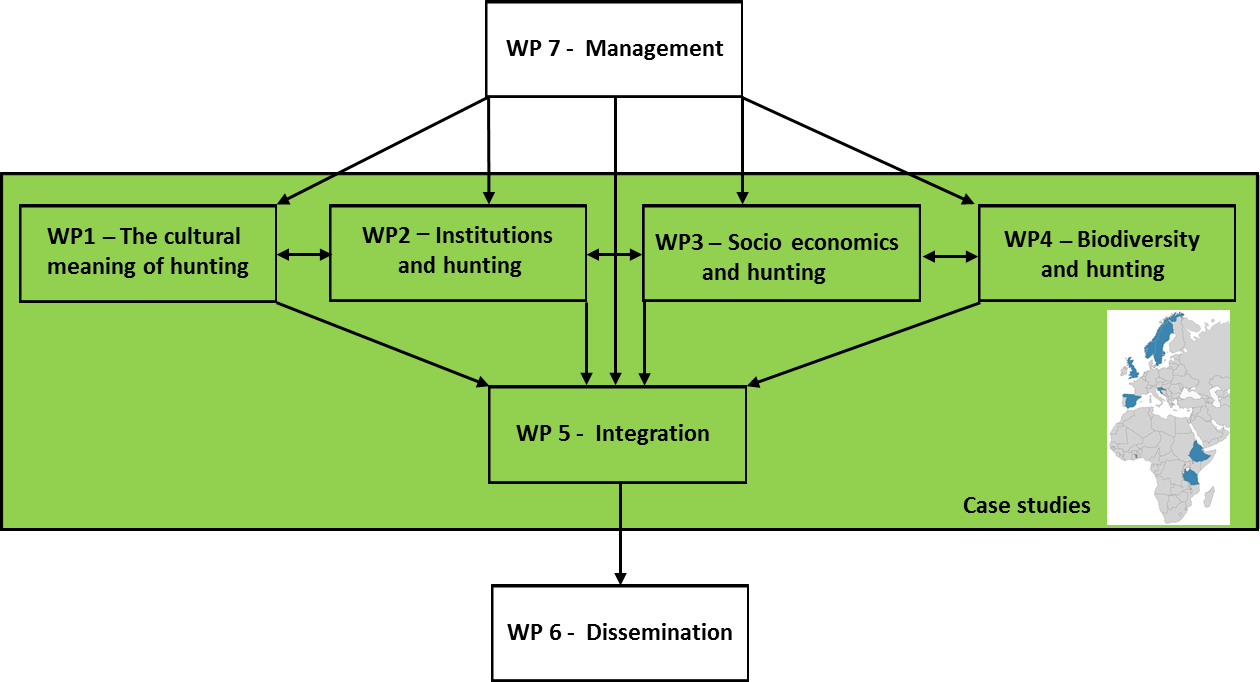Integrating research in HUNT
To deal with research questions on the sustainability of hunting and the extent to which policies can be developed to effectively integrate hunting with biodiversity conservation outside protected areas, the HUNT project required collaboration between ecology, economics and social sciences.
The challenge is to find ways of understanding the often diverging interests and priorities amongst stakeholders and integrating different disciplinary approaches to ensure a fair, full and inclusive framework for representing interactions with biodiversity through hunting.
To do this, HUNT was structured into seven work packages across six case study regions in Europe and Africa. These work packages (Fig. 3) reflect the key disciplinary approaches needed to:
- Understand the institutions, beliefs, perceptions and preferences that influence hunting behavior and the effectiveness of biodiversity conservation (WP1-3).
- Establish and improve methods to determine the sustainability of hunting in terms of their social and economic importance for reducing the vulnerability of livelihoods and husbanding biodiversity (WP3-4).
- Improve capacity to deal with conflict over the multifunctional uses and preservation of biodiversity (WP5).
- Contribute to the development of policy instruments and tools for conflict reconciliation over hunting and conservation (WP5-6).

Figure 3. Structure of the HUNT project and interactions between the work packages, all contributing to the overall aim of informing strategies for sustainability and conservation of biodiversity outside protected areas.
To evaluate how effective this framework was for developing and maintain collaboration across a diverse range of disciplinary inputs and stakeholder contexts through the course of the project, HUNT researchers completed two questionnaires, one near the beginning of the project and the other at the end.
Key findings
As the project has just ended, the questionnaire results are still under analysis. Briefly, therefore, Questionnaire 1 assessed the expectations of integration amongst the researchers and suggested methods of facilitating integration. Responses indicate that many participants viewed the project as an opportunity to overcome barriers to interdisciplinary working, such as poor communication, lack of resources and divergent objectives. Researchers suggested that collaborating across work packages would allow them to identify important knowledge gaps in relation to sustainable hunting, and that working closely with other disciplines on case studies would add necessary expertise to address complex research questions. Ensuring practical ways of investing in relationships through effective and structured communication was viewed as critical to ensure that opportunities for learning from one another were maximised. Optimising the use of communications technology along with understanding and facilitating interactions between individuals, to manage power and hierarchical relationships were considered important for successful integration.
Questionnaire 2 indicated researcher experiences of integration, particularly how well it suited the needs of the project as well as meeting the expectations of the researchers. This included sharing of data and co-authored publications across the work packages. Preliminary results suggest that separation of disciplines by work package can help structure research, but may hinder integration, particularly where methods in different work packages (e.g. modelling) are unfamiliar. Responses highlight the importance of early stage discussion to increase understanding of different disciplinary approaches and consider how best to integrate disciplines and work packages before researchers become focussed on data generation. In particular, this includes understanding the role of models and extent to which they can be used for integration without compromising the quality of contributing disciplinary data.